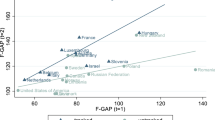Abstract
The large difference in the level and variance of student performance in the 2000 PISA study between Finland and Germany motivates this paper. It analyses why Finnish students showed a significantly higher performance by estimating educational production functions for both countries, using a unique micro-level dataset with imputed data and added school type information. The difference in reading proficiency scores is assigned to different effects, using Oaxaca–Blinder and Juhn–Murphy–Pierce decomposition methods. The analysis shows that German students and schools have on average more favorable characteristics except for the lowest deciles, but experience much lower returns to these characteristics in terms of test scores than Finnish students. The role of school types remains ambiguous. Overall, the observable characteristics explain more of the variation in test scores in Germany than in Finland.
Similar content being viewed by others
References
Adams R, Wu M (2002) PISA 2000 technical report. OECD, Paris
Ammermueller A, Heijke H, Woessmann L (2005) Schooling quality in Eastern Europe: Educational production during transition. Econ Educat Rev 24:579–599
Artelt C, Schiefele U, Schneider W, Stanat P (2002) Leseleistungen deutscher Schülerinnen und Schüler im internationalen Vergleich (PISA). Z Erziehungswissenschaften 5:6–27
Baumert J, Deutsches PISA-Konsortium (2001) PISA 2000: Basiskompetenzen von Schülerinnen und Schülern im internationalen Vergleich. Leske und Budrich, Opladen
Bishop J, Woessmann L (2004) Institutional effects in a simple model of educational production. Educat Econ 12:17–38
Blau F, Kahn L (1992) The gender earnings gap: learning from international comparisons. In: American Economic Review, Papers and Proceedings of the Hundred and Fourth Annual Meeting of the American Economic Association 82:533–538
Blinder A (1973) Wage discrimination: Reduced form and structural estimates. J Human Resour 8:436–455
Eurybase (2003) The information network on education in Europe. http://www.eurydice.org, visited October 24th 2003
Fertig M (2003) Who’s to blame? The determinants of German student’s achievement in the PISA 2000 study. IZA Discussion Paper No. 739, Bonn
Garcia J, Hernández P, López-Nicolás A (2001) How wide is the gap? An investigation of gender wage differences using quantile regression. Empirical Econ 26:149–167
Hambleton R, Swaminathan H (1989) Item response theory. Principles and applications. Kluwer, Boston
Hanushek E, Luque J (2003) Efficiency and equity in schools around the world. Econ Educat Rev 22:481–502
Jann, B (2005) Standard errors for the Blinder–Oaxaca decomposition. http://repec.org/dsug2005/ oaxaca_se_handout.pdf
Juhn C, Murphy K, Pierce B (1993) Wage inequality and the rise in returns to skill. J Polit Econ 101:410–442
Lauer C (2000) Gender wage gap in West Germany: How far do gender differences in human capital matter? ZEW Discussion Paper No. 00–07, Mannheim
Oaxaca R (1973) Male-female wage differentials in urban labor markets. Int Econ Rev 14:693–709
OECD (2001) Knowledge and skills for life: First results from PISA 2000. OECD, Paris
Silverman B (1986) Density estimation for statistics and data analysis. Chapman& Hall, London
Todd P, Wolpin K (2003) On the specification and estimation of the production function for cognitive achievement. Econ J 113:F3–F33
Välijärvi J, Linnakylä P, Kupari P, Reinikainen P, Arffman I (2002) The Finnish success in PISA – and some reasons behind it. http://www.jyu.fi/ktl/pisa/publicationl.pdf
West M, Woessmann L (2006) Which school systems sort weaker students into smaller classes? International Evidence. European J Polit Econ (in press)
Woessmann L (2003) Schooling resources, educational institutions, and student performance: The international evidence. Oxford Bull Econ Statist 65:117–170
Author information
Authors and Affiliations
Corresponding author
Rights and permissions
About this article
Cite this article
Ammermueller, A. PISA: What makes the difference?. Empirical Economics 33, 263–287 (2007). https://doi.org/10.1007/s00181-006-0102-5
Received:
Accepted:
Published:
Issue Date:
DOI: https://doi.org/10.1007/s00181-006-0102-5




